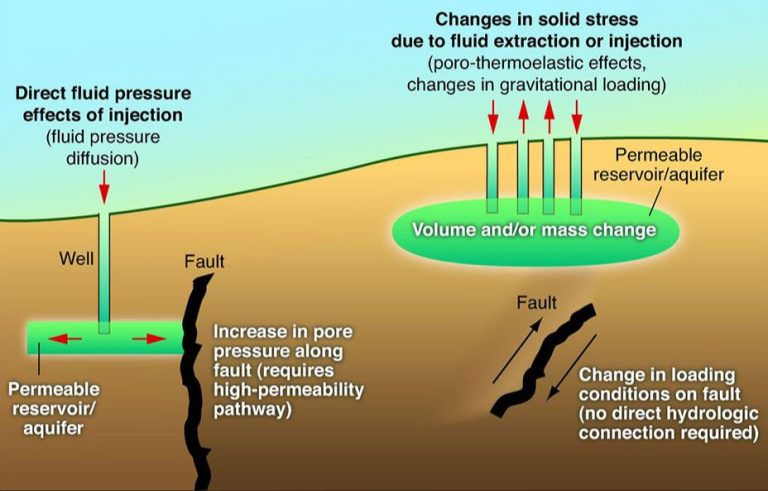Is Geothermal Energy Worth Investing In?

Geothermal energy is thermal energy generated and stored in the Earth. The word geothermal comes from the Greek words geo (earth) and therme (heat). Geothermal energy originates from the heat within the earth’s core and in some areas rises close enough to the surface to be economically utilized to produce electricity. The earth’s core temperature averages between 4,000 and 6,500°C. The heat within the earth continuously flows to the surface by conduction and convection. The high subterranean temperature and permeability of certain locations make geothermal energy production viable. There is debate around whether geothermal energy is a viable and economical energy source that should be further invested in for large scale energy production. This article examines the question: Is geothermal energy worth investing in?
How Geothermal Energy Works
Geothermal energy utilizes heat from within the earth to generate electricity. It starts with hot water or steam reservoirs located deep underground in naturally occurring geologic hot spots. These reservoirs can reach temperatures of over 700°F. The high temperatures are mainly the result of decay of radioactive elements like potassium-40 and thorium-232 in the earth’s core. This process has been occurring for billions of years and produces a nearly endless supply of thermal energy (1).
Wells are drilled 1-2 miles deep into these geothermal reservoirs to tap the hot water or steam. The hot water or steam then rises up through the production wells to the surface, where it is channeled into pipes. The steam goes directly to a turbine that powers a generator to produce electricity. For geothermal plants using hot water, the water is flashed into steam which then goes to the turbine. The used steam exiting the turbine contains 80-90% of the thermal energy from the reservoir, so it is recycled to condense it back into water for re-use (1).
The areas best suited for geothermal power plants are located near tectonic plate boundaries where volcanic activity brings hot rock closer to the surface. Significant geothermal energy potential exists in the western U.S., Alaska, and Hawaii where hot springs and geysers are common. With advanced technologies, even areas without obvious surface activity can produce geothermal power by drilling deeper to tap underground reservoirs.
Sources:
(1) https://www.energy.gov/eere/geothermal/electricity-generation
Types of Geothermal Power Plants
There are three main types of geothermal power plants:
Dry steam power plants – These plants use steam directly from a geothermal reservoir to turn the turbine generators. The first geothermal power plant was a dry steam plant built in Italy in 1904. This is the simplest type of geothermal power plant.
Flash steam power plants – These plants take high-pressure hot water from deep inside the earth and convert it to steam to drive the turbines. When the steam cools, it condenses to water and is injected back into the ground to be reheated. Flash steam plants are the most common type of geothermal power plant today.
Binary cycle power plants – These plants pass the hot fluid from the reservoir through a heat exchanger to heat a separate fluid with a much lower boiling point, which vaporizes and drives the turbine. The used fluid is then injected back into the ground. Binary cycle plants emit very few greenhouse gases.
Advantages of Geothermal
There are several key advantages that make geothermal a promising renewable energy source worth investing in:
It is a clean, renewable power source. Geothermal plants emit little to no greenhouse gases or other pollutants (Source: https://www.enelgreenpower.com/learning-hub/renewable-energies/geothermal-energy/advantages).
Geothermal provides constant base load power unaffected by weather changes, unlike solar or wind power. The plants can operate 24/7 with 90% uptime (Source: https://www.twi-global.com/technical-knowledge/faqs/geothermal-energy/pros-and-cons).
It reduces reliance on fossil fuels like coal and natural gas that produce greenhouse gas emissions driving climate change.
Geothermal plants require less land area than solar or wind farms to produce an equivalent amount of electricity.
Disadvantages and Challenges
While geothermal energy has many benefits, it also comes with some drawbacks and limitations that need to be considered.
One of the biggest disadvantages of geothermal energy is the high upfront costs required for geothermal power plant construction and drilling. Geothermal plants are expensive to build, with costs ranging from $2-5 million per megawatt of electricity generating capacity. The drilling required to reach geothermal reservoirs can also be costly, especially for enhanced geothermal systems located deep underground.
Another challenge is that geothermal energy is limited to areas with adequate geothermal resources and activity. Not all locations have hot enough underground temperatures or permeable reservoir rocks required to economically produce geothermal power. This restricts widespread adoption of geothermal energy.
There are also potential emissions risks, such as release of hydrogen sulfide gas or carbon dioxide from geothermal reservoirs. Proper plant operation and emission control systems are needed to minimize this. Additionally, over-withdrawal of geothermal fluids can cause subsidence or ground sinking at power plant sites, which needs to be monitored and managed.
While geothermal power offers a clean, renewable energy source, its high upfront capital costs, geographical limitations, and potential environmental impacts pose disadvantages that must be considered for future geothermal investments.
Global Geothermal Energy Capacity
Global geothermal energy capacity has been gradually increasing over the last decade. According to the International Renewable Energy Agency, global installed geothermal capacity reached about 14.9 gigawatts in 2022. Geothermal energy currently accounts for only 0.5% of renewable energy used for electricity generation and heating/cooling worldwide.
The countries with the most installed geothermal capacity in 2022 were the United States (3,800 MW), Indonesia (2,563 MW), Philippines (1,930 MW), Turkey (1,600 MW), and New Zealand (1,135 MW), according to ThinkGeoEnergy. The United States generates the most electricity from geothermal energy, meeting about 0.4% of its electricity demand. Indonesia utilizes geothermal for about 5% of its electricity generation. The Philippines sources over 15% of its electricity from geothermal, the highest share in the world.
While growth has been steady, geothermal energy expansion has slowed in the last decade. Annual geothermal capacity additions were over 500 MW per year between 2010-2014, but have since fallen below 400 MW added per year, according to Statista. However, many experts estimate accelerated growth in the coming decades as technology improves and more investment is made globally.
Costs
The levelized cost of geothermal energy ranges from $0.04 to $0.10 per kWh according to the U.S. Department of Energy [1]. This makes it competitive with conventional fossil fuel plants and cheaper than solar PV or offshore wind. The bulk of geothermal costs are upfront capital costs rather than fuel costs, as the thermal energy comes from the earth itself.
For residential installations, the average upfront cost is $18,000 to $30,000 [2]. This is higher than installing a conventional furnace or air conditioner. However, geothermal systems can save homeowners 20-60% on heating/cooling bills over the lifetime of the system due to their greater efficiency [3]. With federal tax credits, most geothermal systems can pay for themselves in 5-10 years.
For utility-scale plants, geothermal remains cost-competitive despite high upfront drilling costs. The levelized cost is estimated at $76 per MWh, undercutting coal at $94/MWh and on par with natural gas combined cycle at $75/MWh [1].
Environmental Impacts
Geothermal power plants generate very low emissions compared to fossil fuel plants. However, some greenhouse gases are emitted during the extraction, processing, and transportation of geothermal resources. According to the U.S. Energy Information Administration, geothermal plants emit on average less than 5% of the carbon dioxide emissions of a fossil fuel plant per kilowatt-hour of electricity generated (Geothermal energy and the environment).
Geothermal power plants use water pumps to bring hot water and steam to the surface. The used geothermal fluids are then injected back into the earth. This can impact the quality and availability of groundwater resources, if not managed properly. The U.S. Fish and Wildlife Service states that pumping geothermal fluids can deplete natural reservoirs and cause subsidence of land (Geothermal Energy | U.S. Fish & Wildlife Service). Proper site selection, fluid injection, and reservoir management can help mitigate water usage impacts.
Geothermal power plants require less land area than fossil fuel or nuclear plants. However, infrastructure such as wells, pipelines, and roads can disrupt habitats and sensitive ecosystems if not properly located and managed. According to the Union of Concerned Scientists, geothermal development can fragment wildlife habitat and disrupt migration routes, but impacts can be minimized through careful planning (Environmental Impacts of Geothermal Energy).
Government Support and Incentives
The U.S. government provides various incentives and funding to support the development of geothermal energy. This includes research grants, tax credits, loans, and other initiatives.
The U.S. Department of Energy (DOE) runs the Geothermal Technologies Office which conducts research and provides funding opportunities for geothermal projects. In February 2023, the DOE announced $74 million in funding for up to seven enhanced geothermal system (EGS) pilot projects across the country [1]. EGS technology can produce geothermal energy from areas that lack natural hydrothermal resources but have suitable hot rock conditions.
The Bipartisan Infrastructure Law passed in 2021 provides up to $84 million for geothermal demonstration projects, including the $74 million in EGS funding. The law also extends the geothermal Investment Tax Credit which provides a 26% credit for geothermal projects that start construction before the end of 2032 [2].
At the state level, California offers initiatives like the Geothermal Grant and Loan Program which provides grants and loans for geothermal development. Many other states such as Nevada, Utah, and Oregon also offer various tax credits and incentives for geothermal [3].
Conclusion
In summary, geothermal energy shows significant potential as a valuable renewable energy source, but it also has some limitations. The main benefits of geothermal are its reliability, low emissions, and cost-competitiveness with fossil fuels in certain locations. However, high upfront costs and geographical restrictions mean it is not universally viable. Overall, investing in geothermal energy seems worthwhile in areas with suitable underground heat resources, especially with supportive government incentives. It can provide a sustainable baseload power solution and diversify the energy mix. While not yet scalable globally, geothermal warrants continued growth and innovation to help decarbonize the energy sector. With the right conditions, geothermal can be a smart investment for utilities, asset managers, and governments seeking reliable clean energy.





